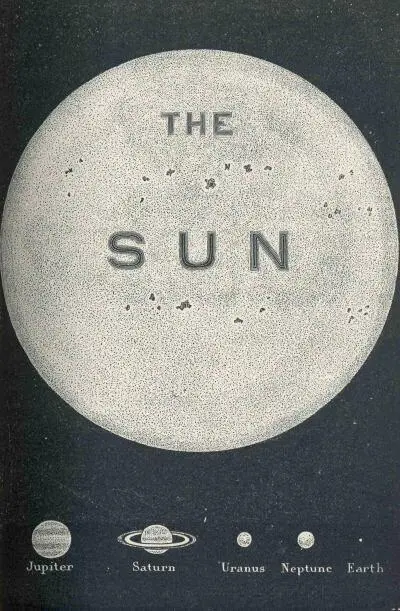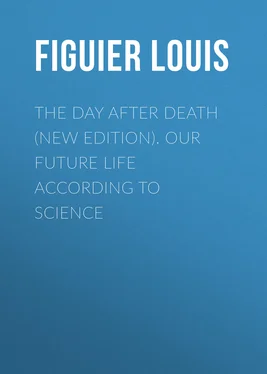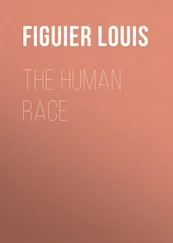Louis Figuier - The Day After Death (New Edition). Our Future Life According to Science
Здесь есть возможность читать онлайн «Louis Figuier - The Day After Death (New Edition). Our Future Life According to Science» — ознакомительный отрывок электронной книги совершенно бесплатно, а после прочтения отрывка купить полную версию. В некоторых случаях можно слушать аудио, скачать через торрент в формате fb2 и присутствует краткое содержание. Жанр: Эзотерика, foreign_religion, foreign_antique, foreign_prose, на английском языке. Описание произведения, (предисловие) а так же отзывы посетителей доступны на портале библиотеки ЛибКат.
- Название:The Day After Death (New Edition). Our Future Life According to Science
- Автор:
- Жанр:
- Год:неизвестен
- ISBN:нет данных
- Рейтинг книги:5 / 5. Голосов: 1
-
Избранное:Добавить в избранное
- Отзывы:
-
Ваша оценка:
- 100
- 1
- 2
- 3
- 4
- 5
The Day After Death (New Edition). Our Future Life According to Science: краткое содержание, описание и аннотация
Предлагаем к чтению аннотацию, описание, краткое содержание или предисловие (зависит от того, что написал сам автор книги «The Day After Death (New Edition). Our Future Life According to Science»). Если вы не нашли необходимую информацию о книге — напишите в комментариях, мы постараемся отыскать её.
The Day After Death (New Edition). Our Future Life According to Science — читать онлайн ознакомительный отрывок
Ниже представлен текст книги, разбитый по страницам. Система сохранения места последней прочитанной страницы, позволяет с удобством читать онлайн бесплатно книгу «The Day After Death (New Edition). Our Future Life According to Science», без необходимости каждый раз заново искать на чём Вы остановились. Поставьте закладку, и сможете в любой момент перейти на страницу, на которой закончили чтение.
Интервал:
Закладка:

Fig. 1.—Comparative Dimensions of the Sun and the Planets.
Weight is thirty times more intense on the surface of the sun than on the earth. We know that a body which falls upon the earth traverses, in the first second of its fall, a space of four metres, nine centimetres. In the sun a falling body traverses 144 metres in the first second of its fall. It follows from this, that a human body, if transported to the sun, would weigh about 2000 kilogrammes, the weight of an elephant. The body of a dog or of a horse would weigh twenty-eight times as much as upon our earth, so that these animals would remain fixed to the surface. The conditions of nature must therefore be entirely different in the sun from what they are in the group of planets to which the earth belongs.
The sun sheds rays from perpetual fire, a characteristic that appertains to him alone among all the stars of our world. Of himself he burns, and sheds abroad light and heat. The other stars are neither warm nor luminous, and if the sun did not exist, they would be plunged into eternal darkness and eternal cold. This privilege alone ought to make us comprehend the immense importance of the central star.
The light and heat which emanate from the sun are constant; they are never interrupted, and they never lose their force. Thus, a second characteristic—constancy of illumination—separates the sun from all the other celestial bodies of our world.
The intensity of the real heat of the sun has been measured by the physicists. This result was attained in an endeavour to determine by experience the quantity of heat which accumulates in a given time, upon a certain portion of the earth's surface, exposed to the sun's rays, and adding to that element the quantities of heat which would be absorbed by the atmospheric air, the ethereal spaces, and the soil.
Pouillet, the French physicist, who undertook this critical investigation, arrived at certain results, which he states as follows:
"If the total quantity of heat emitted by the sun was exclusively employed to melt a layer of ice applied to the solar globe, and covering it completely in all its parts, that quantity of heat would be able to melt, in one minute, a layer of eleven metres, eighty centimetres, and in one day a layer of seventeen kilometres in thickness."
"'This same quantity of heat,' says Professor Tyndall, 'would boil 2900 milliards of cubical kilometres of water, at the temperature of ice.'"
The astronomer Herschel found, that, in order to extinguish the sun, to prevent his "giving out caloric," according to the scientific phrase, it would be necessary to dash a stream of iced water, or a cylindrical column of ice, eighteen leagues in diameter, against its surface, at a rate of speed of 70,000 leagues per second. A comparison adopted by Professor Tyndall gives us an amazing view of the intensity of the calorific force of the sun. "Imagine," says he, "that the sun is surrounded by a layer of peat, seven leagues in thickness, the heat produced by its combustion would be the same as that produced by the sun in one year." The physicists have measured the intensity of the sun's light with exactitude, as they had previously measured his heat.
It is known that the solar light is 300,000 times stronger than that of the full moon, and 765,000,000 stronger than that of Sirius, the most brilliant of the stars.
Bouguer discovered, by experiments made in 1725, that the sun, at a height of 31° above the horizon, gives a light equal to that of 11,664 candles, placed within 43 centimetres of the object to be lighted, and equal to 62,177 candles placed within one metre.
According to this result, if we take account of atmospheric absorption, and of the law of the variation of the intensity of light, which decreases in inverse ratio to the square of distance, the light given by the sun at its zenith would be 75,200 times greater than that of a single candle, placed within one metre. Wollaston had arrived at a similar conclusion. By means of experiments of another kind, made during the months of May and June, 1799, Wollaston found that 59,882 candles, at one metre, give as much light as the sun. Supposing the sun to be in the zenith, the lightening power of that great star would be equivalent to 68,009 candles.
There is but little difference between this valuation and that of Bouguer, who states the result at 75,200 candles.
Whatever may be the intensity of the light of the sun, we now possess other sources of light which approach to it. Such is the oxhydric light, produced by burning hydrogen gas by means of a current of oxygen gas, or air, a method of lighting which has recently been employed in Paris and in London. This light is equal in power to more than 200 candles. A thread of magnesium burning in the air, develops a prodigious quantity of light, which may be taken as equivalent to that of 500 candles. The electric light produced by a voltaic battery of from 60 to 80 coils, produces a luminous arc equal to the light of 800 or 1000 candles. In the latter instance the voltaic arc, according to Bouguer and Wollaston, would give 75 times less light than the sun, supposing the luminous electric point to be placed at a distance of one metre.
With very powerful batteries, it has been possible to go further, and produce a light not much inferior to that of the sun. Messieurs Fizeau and Foucault, by comparing the light of a voltaic arc, produced by the action of three series of Bunsen's coils, of forty-six couples each, with the light of the sun in a clear sky in April, have established that the light-giving power of the sun is not more than twice and a half that of the electric light.
The preceding numbers represent the light-giving power of the sun upon our globe, taking into account atmospheric absorption. Arago, on endeavouring to determine the intrinsic light-giving power of the sun, found that the intensity of the solar light is 52,000 times greater than that of a candle placed at one metre. But, according to more recent researches for which we are indebted to Mr. Edmond Becquerel, the result obtained by Arago is greatly inferior to the truth, and the light of the central star is 180,000 times greater than that of a candle placed at one metre.
All the planets, attended by their satellites, and all the comets which accidentally manifest themselves to us, turn round the sun. The sun remains motionless in the midst of this imposing procession of stars, which circulate around him, like so many courtiers paying him homage.
Thus, the sun is the heart of our planetary system; everything is drawn, everything converges towards him.
Half-informed persons will exclaim, "What can be more simple! The sun being six hundred times the size of all the other stars put together, the phenomenon of the condition of all those stars around the sun is explained by the law of attraction, which prescribes that bodies shall attract in proportion to their mass. If the sun attracts the stars of our world to itself, it is because his mass is greater than that of all the other stars collectively." But such an answer would be erroneous, involving the common error of taking a word for a thing, an hypothesis for an explanation, of putting a term of language in the place of a logical consideration. When Newton conceived the hypothesis (and the phrase) of reciprocal attraction of matter , he was careful to state that he only proposed to characterise by a name a phenomenon which in itself is entirely inexplicable, and of which we know nothing but the exterior mode of its manifestation, that is to say, the mathematical law. We know that bodies go towards each other in the ratio of their masses, and in the inverse ratio of the square of their distances; but why do they go towards each other? This is what we do not know, and what we probably never shall know. If, for the word attraction we were to substitute the word electrization , or, as Keppler did, the words affection , sympathy , obedience , &c., we should have a new hypothesis, with a new name, but the mathematical law would remain the same, the hypothesis only would be changed. The real cause which makes small bodies rush towards large ones, and the stars of lesser magnitude revolve round the stars of greater magnitude, is an impenetrable mystery to mankind.
Читать дальшеИнтервал:
Закладка:
Похожие книги на «The Day After Death (New Edition). Our Future Life According to Science»
Представляем Вашему вниманию похожие книги на «The Day After Death (New Edition). Our Future Life According to Science» списком для выбора. Мы отобрали схожую по названию и смыслу литературу в надежде предоставить читателям больше вариантов отыскать новые, интересные, ещё непрочитанные произведения.
Обсуждение, отзывы о книге «The Day After Death (New Edition). Our Future Life According to Science» и просто собственные мнения читателей. Оставьте ваши комментарии, напишите, что Вы думаете о произведении, его смысле или главных героях. Укажите что конкретно понравилось, а что нет, и почему Вы так считаете.












